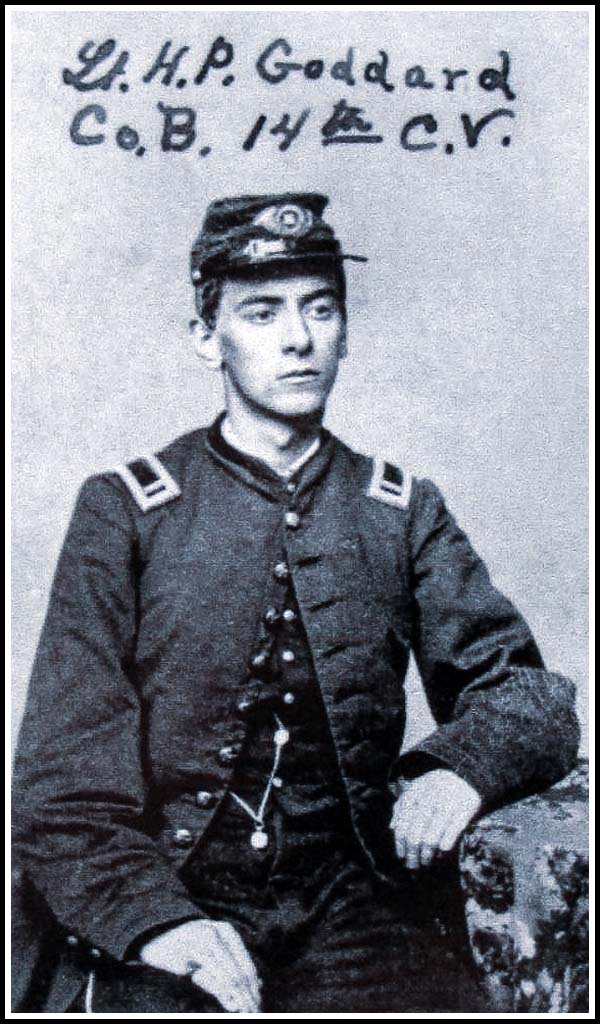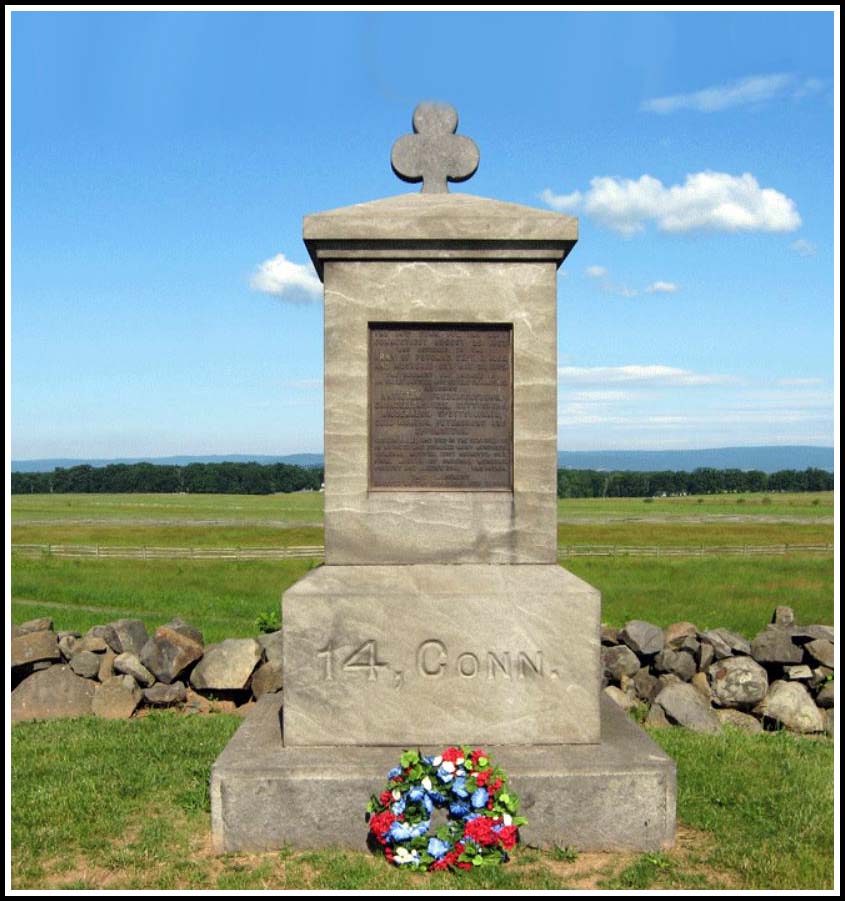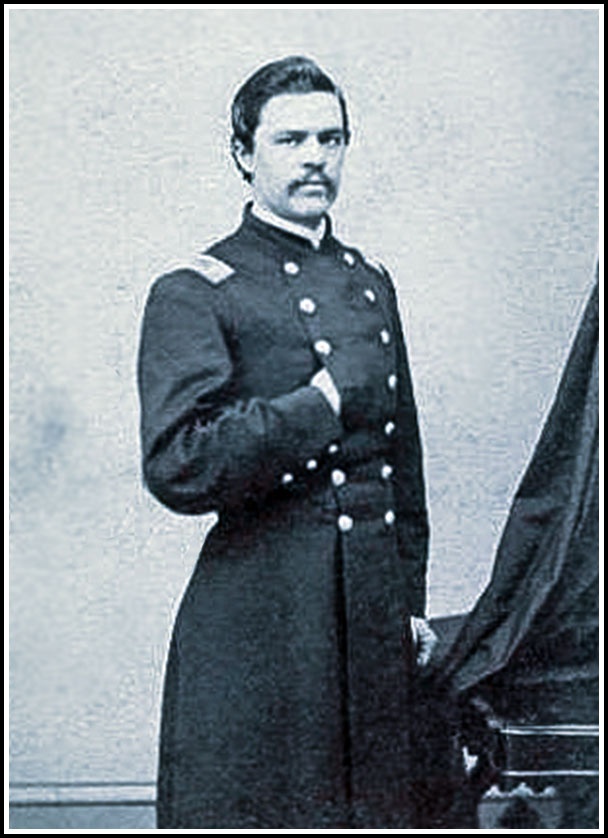13th Connecticut Volunteers on the Banks of the Mississippi River
13th Connecticut Volunteer
Infantry Regiment
The 13th Connecticut Volunteer Infantry Regiment was organized in New Haven beginning on November 25, 1861 and mustered in on January 7, 1862. The men of the 13th CVI regiment signed up for a 3-year period of service.
Many of the command, staff and ranks were from Norwich. The Commanding Officer Major Henry W. Birge, Quartermaster Joseph R. Bromley; Adjutant George W. Whittlesey; 2nd Assistant Surgeon Nathan A. Fisher; to name a few. The total number of volunteers from Norwich in the 13th CVI was approximately 60.
The unit was always noted for its fine appearance and neat equipment. They fought in 13 engagements throughout the war, primarily in Louisiana and Georgia. Click HERE to see complete list.
The unit was assigned to the Department of the Gulf and was sent to New Orleans, arriving on May 15, 1862. Up until that time the presence of Union soldiers in New Orleans was very unpopular and many of the women there staged a campaign of insults, disrespect and bitterness against the Union soldiers. It is unknown if the soldiers of the 13th CVI were subjected to this treatment, but it is known that their garrison duty in New Orleans was fairly uneventful.
By December 1862, Major General Nathaniel Banks was forming a 35,000 man force, with the intent of moving against the Confederate stronghold at Port Hudson on the Mississippi River. Colonel Birge was placed in command of the 3rd Brigade of the 4th Division of General Banks’ Department of the Gulf. The 13th CVI Regiment was one component of Birge’s brigade.
The 13th CVI regiment was intended to be held in reserve during the siege at Port Hudson, but, the unit’s historian reported, “by sheer force of enthusiasm and stress of the emergency, it worked its way to the fore-front of the hottest battle”. On May 26, 1863 the Union forces unsuccessfully attacked at Port Hudson. Subsequently on June 14, 1863 a second assault failed disastrously. After these failed attempts, General Banks then called for 1,000 volunteers, who would be given special training, to launch one final, desperate attempt to take the fort. The historian for the 13th CVI called it the mission of Forlorn Hope, due to its inherent danger.
Colonel Birge volunteered to command an elite storming party. The party was made up of carefully chosen volunteers, mostly men from the 13th CVI, organized into two battalions of eight companies each. All the men were well aware that the mission would be extremely dangerous and many would not return. They trained daily for its undertaking and on June 28, Birge and his 67 officers and 826 enlisted men (241 from the 13th CVI) reported for duty. The attack was planned for July 7, 1863. Fortunately, the assault never occurred due to the surrender of the Confederate forces at Vicksburg on July 4, 1863.
The regimental history called the Forlorn Hope group one of the most heroic undertakings of the Civil War, an “impeccable memorial of the self-sacrifice and courage of the men, and their leader, both of whom the country had every reason to feel proud”
The 13th CVI mustered out of service on April 25,1866 at Fort Pulaski, Georgia.
“The Norwich Memorial: The Annals of Norwich, New London County, Connecticut in the Great Rebellion of 1861-65,” 1873, p 51, by Malcom McGregor Dana
“The Photographic History of the Civil War,” 1911, p 41, by Francis Trevelyan Miller
The complete list of sources may be found by clicking the “Bibliography” button, and, then typing “13th Connecticut Regiment” in the SEARCH box.
14th Connecticut Volunteer Infantry Regiment
By April 1862 the Union forces were making steady progress and as a result the War Department discontinued recruiting services in all the Union states. However, several months later on July 1, 1862 President Lincoln issued a third proclamation calling for 300,000 men to serve for three years.
In response, Governor William A. Buckingham announced the need for more men and organized a meeting in Norwich at Breed Hall on July 13, 1862. Similar to previous Civil War meetings, the hall was tastefully decorated with flags and buntings and was crowded with enthusiastic citizens. During the meeting it was resolved to form a committee, comprised of many Norwich leaders, whose duty was to “take such measures as may be necessary to procure the speedy enlistment of troops”.

Henry P. Goddard
The committee decided to offer as bounty (i.e. incentive) to those volunteering from Norwich $13, ($425 in 2021 dollars) in addition to the money promised by Connecticut and U.S. Government. Norwich’s additional incentive resulting in a sum of $100, ($3,275 in 2021 dollars) for each recruit.
After two other mass meetings, one at Franklin Square and another at Breed Hall, approximately 65 men volunteered. Twenty-five of them became members of Company E of the 14th CVI Regiment led by Captain William H. Tubbs.
When Company K formed Lieutenant James B. Coit was promoted to Captain and became the company commander. His sergeant-major was Henry P. Goddard, pictured on the left. Within three months Goddard was promoted to 2nd lieutenant.
Goddard and the regiment got their “baptism of fire” at the Battle of Antietam. Later, at Fredericksburg, Goddard’s heroism saved the life of the regiment’s commander, Col. Sanford Perkins, and his bullet-ridden canteen probably saved his own life. This is but one of many of Henry’s wartime experiences.
His family was deeply rooted in Norwich affairs. His father, Levi, had graduated from Cambridge Law School, and was a practicing attorney in Norwich. His grandfather, Calvin Goddard, a former mayor of Norwich, graduated from Dartmouth College and was also a lawyer. In 1833 Calvin Goddard defended Prudence Crandall in what is considered as one of the first civil rights cases in the United States.
Before joining the army, Henry was a reporter for the Norwich Bulletin. Throughout his service to the Union Army, Lt. Goddard kept a diary, sent letters home and sent reports to the newspaper. These works were collected and formed into a book by his great-grandson, Calvin Goddard Zon. You can get a copy of it HERE.
Volunteers from all over Connecticut gathered at Camp Foote in Hartford and mustered together to form the 14th CVI Regiment on August 23, 1862. After a very short, inadequate, training period the regiment left Hartford on August 25, 1862 and was at once ordered into the hard-fought Battle of Antietam . The regiment’s losses were great at Antietam. It was under fire for 36 hours with scarcely anything to eat or drink.

After Antietam, the 14th CVI regiment was in almost constant active service. Beginning with the Battle of Fredericksburg they fought in seven more major battles. The regiment also fought at the Battle of Gettysburg. As a memorial to their brave actions two monuments were erected in Gettysburg, PA. The front face on one of the monuments reads :
“The 14th Conn. Vol. Inf. left Connecticut August 25, 1862; was assigned to the Army of the Potomac, Sept. 7, 1862 and mustered out May 31, 1865. The Regiment was engaged in 34 great battles and severe skirmishes, including Antietam, Fredericksburg, Chancellorsville, Gettysburg, Wilderness, Spotsylvania, Cold Harbor, Petersburg and Appomattox. Lost in killed and died in the service, 366; in wounded and disabled many hundreds. Original muster 1015; recruits 697,Final muster of original members, present and absent, 234, pro patria. This monument erected by the survivors, July 3, 1884.”
There are 2 other monuments that specifically honor of the 14th CVI Regiment at the Gettysburg battleground and 1 monument that was erected on the Antietam battlefield.
The regiment was present at the surrender of Lee and was mustered out May 1865.
“The Norwich Memorial: The Annals of Norwich, New London County, Connecticut in the Great Rebellion of 1861-65,” 1873, pp 60-61, by Malcom McGregor Dana
“Henry Perkins Goddard,” by Members.Tripod.com
The complete list of sources may be found by clicking the “Bibliography” button, and, then typing “14th Connecticut Regiment” in the SEARCH box.
18th Connecticut Volunteer Infantry Regiment
The 18th Connecticut Volunteer Regiment (18th CVI regiment) was recruited in New London, Windham and Tolland counties and on July 28, 1862 was sent to “The Fair Grounds” area of Norwich, site of present-day Three Rivers Community College, by Governor William A. Buckingham. They stayed at this location, known as Camp Aiken (in honor of General William A. Aiken), for nineteen days before leaving for the front.

The 18th CVI regiment was the first full regiment to muster in Norwich and as a result, it was heavily populated with men from Norwich. The regiment was commanded by Colonel William G. Ely. Five of his staff officers and five company commanders (Companies A, C, E, F, and I) were from Norwich. In all, more than 250 of the regiment’s 1000 men were from Norwich.
The 18th CVI regiment “colors”, a gift from the women of Norwich, was presented to Colonel Ely by Governor William A. Buckingham on August 22, 1862. Immediately thereafter, the men formed a line and marched into the city to embark on their destination; Baltimore, Maryland. For several months, they served to strengthen defenses of nearby Fort McHenry and Fort Marshall.
Civil War regiments typically carried several flags. They carried the Union (National flag), the Regimental Colors (a.k.a. the State flag) and flank marker flags. During battle the Regimental colors were placed at the center of the regiment. Flank marker flags, carried by Sergeants, were smaller than the Regimental colors and posted at each end of the regimental line during battle.

Henry Peale returned to Norwich where he continued his trade of carpenter and builder. His home was at the corner of Pearl and Asylum Streets, his business at Norwich Central Wharf, and he served as Fire Chief for the City of Norwich from 1860-1862. Henry died June 1898 and is buried in the Peale family plot in Yantic Cemetery.
The 18th CVI regiment later fought at the Battle of New Market, the Battle of Piedmont and the Second Battle of Kernstown.
After the war, the regiment mustered out at Harpers Ferry, West Virginia on June 27, 1865. Over its entire three-year period of service it lost 152 men. 71 were killed or mortally wounded and 81 died of disease.
“The Norwich Memorial: The Annals of Norwich, New London County, Connecticut in the Great Rebellion of 1861-65,” 1873, pgs 62-70, 261, by Malcom McGregor Dana
18th CVI regiment Facebook web page
The complete list of sources may be found by clicking the “Bibliography” button, and, then typing “18th Connecticut Volunteer” in the SEARCH box.
26th Connecticut Volunteer Infantry Regiment
In late August 1862, seven additional regiments of nine months’ volunteers were called for from Connecticut and Norwich took vigorous measures to promptly furnish its quota. Another war meeting was held in Breed Hall, on Wednesday August 27, 1862, presided over by Mayor James Lloyd Greene. The spirit and enthusiasm of Norwich citizens was once again aroused. The war committee announced that the town bounty for new recruits should be increased to one hundred dollars.
Three days later, the people of Norwich assembled at Town Hall to discuss how to pay for the generous bounty. After the group ratified the new bounty, many people volunteered to donate liberal sums of money. The honorable H. H. Starkweather, whose practical wisdom and earnest, devoted patriotism, led off in a donation of $100 ($2650 in today’s dollars) to the first ten men that volunteered. Lewis Edwards promptly made the same offer. Fifty dollars was next proffered by D. A. Delanoy for the third group of 10 that would enlist. The list of generous donations from both private citizens and businessman was long.
The ranks of the 26th CVI regiment quickly grew in Norwich. The commander, most of the regimental staff, and commanding officers of Companies B, D, F, and G were all from Norwich. Additionally the names of 125 privates were on the regimental rolls. The regiment formed on November 14, 1862, marched through the city, where it was enthusiastically greeted and embarked on a steamer headed to New York. Twelve days later, they were sent to New Orleans to support the assault upon Port Hudson. It turned out to be the one and only battle in which they fought.

Soon after General Nathan P. Banks arrived in Louisiana, the 26th CVI regiment joined in the Siege of Port Hudson. On May 27, 1863, Colonel Kingsley, the regiment commander, was wounded in the early part of the action and Lieutenant Colonel Joseph Selden took command. He personally led the regiment and handled it with both courage and skill for the remainder of the siege.
According to Info Source 1 :
“Its bearing in this first engagement in which it came under fire, was highly creditable, the men and officers conducting with decided gallantry and coolness, proving that nine months’ regiments were equal to any emergency. Captain John L. Stanton, a brave officer, esteemed by his comrades, and tenderly loved by his friends, was shot dead in this assault.”
After nearly three weeks of fighting, Port Hudson surrendered to the Union Army. However, the damage incurred on May 27, 1863 was extensive. Colonel Selden reported that 26 men of the 26th CVI were killed and 151 were wounded. Most of the casualties were sustained on the charge “through a storm of grape and cannister from the rebel batteries”.
Place cursor over photo to enlarge
The 26th CVI regiment was honored by being selected as one of the ten to enter and received the formal surrender of Port Hudson on July 9, 1863.
The 26th CVI regiment mustered out of service August 17, 1863. Soon after their discharge, the regiment was welcomed home by a formal ceremony and reception. According to Info Source 2 :
“A banner hung at the entrance welcomed the men home, and another, lettered “Port Hudson”, hung on the speakers’ platform occupied by the governor, the mayor, members of the common council, Colonel Kingsley and others.”
“Sixty years later, the town dedicated a monument commemorating the Twenty-sixth Connecticut Infantry and its heavy losses at Port Hudson.”
The monument, shown on the left, is a 27-foot obelisk with horizontal bands that divide its height into three sections. The monument, located on the Little Plain park near St. Patrick’s Cathedral in Norwich, was dedicated on August 29, 1902.
“The Norwich Memorial: The Annals of Norwich, New London County, Connecticut in the Great Rebellion of 1861-65,”, 1873, pp 82-87, by Malcom McGregor Dana
“Norwich and The Civil War”, (2015), pp 71-72, by Patricia F. Staley
“The Norwich Memorial: The Annals of Norwich, New London County, Connecticut in the Great Rebellion of 1861-65”, (1873), page 261, by Malcom McGregor Dana
by Michael Herrick, posted on The Historical Marker Database website
The complete list of sources may be found by clicking the “Bibliography” button, and, then typing “26th Connecticut Volunteer” in the SEARCH box.
29th Connecticut Volunteer Infantry Regiment


David Torrance
In November 1863 the Connecticut Legislature passed a bill for the enlistment of African-American volunteers. By early 1864, more than 1,600 men volunteered for service. 1,200 of these recruits became members of the 29th Colored Connecticut Infantry Regiment and the remaining 400 joined the 30th CVI Regiment. The 29th CVI regiment organized in Fair Haven, Connecticut and mustered into service on March 8, 1864. The men volunteered for a 2-year period and received the same pay and uniform as other Connecticut volunteers.
Twenty four men from Norwich joined their ranks. David Torrance, shown on the left, was the commander of Company A. Before volunteering for service, he was a mill worker in Norwich. After fighting in the Second Battle of Winchester with the 18th CVI regiment, he was captured and imprisoned at Libby Prison. Torrance later volunteered for service in the 29th CVI regiment. He rose to the rank of Lieutenant Colonel before finishing his service.
The 29th CVI was first sent to Beaufort, South Carolina, (pictured above) as a part of the Ninth Army Corps.
In the latter part of June 1864 they fought in front-line trenches in many small battles while the Union and Confederate armies were locked in a siege between Richmond and Petersburg, Virginia.
From June 1864 through the end of the war in April 1865, the regiment fought in five important battles. The 29th CVI is credited as being the first infantry regiment to enter Richmond, Virginia, when the city surrendered after the Siege of Petersburg.
By late 1865, the 29th CVI regiment and the Connecticut men from the 31st United States Regiment were ordered back home and arrived in Hartford November. All were honorably discharged from service during a large celebration, during which Governor Buckingham thanked the men for their service and noted that “…although Connecticut now denies you privileges which it grants to others…the voice of a majority of liberty-loving freemen will be heard demanding for you every right and every privilege.”
The 29th CVI regiment lost a total of 198 men during service; 1 officer and 44 enlisted men killed or mortally wounded, 1 officer and 152 enlisted men died of disease. Five of the brave volunteer enlisted men from Norwich died while in service : Silas Brown, Moses Stephenson, Charles H. Monroe, Daniel Emmons and Edward Francis.
“The Norwich Memorial: The Annals of Norwich, New London County, Connecticut in the Great Rebellion of 1861-65,” 1873, pp 108-110, by Malcom McGregor Dana
“Beaufort, South Carolina. 29th Regiment from Connecticut,” by Samuel A. Cooley
“David Torrance : Soldier, Lawyer, Ct Secretary of State, Chief Justice State Supreme Court,” Derby Hall of Fame
The complete list of sources may be found by clicking the “Bibliography” button, and, then typing “29th Connecticut Volunteer” in the SEARCH box.